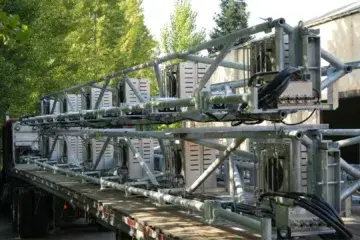At Fish Guidance Systems, we work with all kinds of fish, from lesser known species like Thwait Shad, to household names like Salmon.
Salmon are popular on the fork, the fishing rod and in the classroom. The lifecycle of a salmon is something that is taught in almost every school- with adult salmon returning up vast river networks, leaping over waterfalls, to reach their breeding ground.
But thanks to the increase in infrastructure that we humans have put into river systems, such as dams and agriculture, the vast salmon runs and climbs that are marvelled at around the world are becoming more difficult to achieve, as more barriers are being put in the way.
It is now accepted that reducing these barriers is of the utmost importance, with ladders, culvert, acoustic barriers, and even cannons, being used to help the salmon on their journey.
The importance of salmon
There are many reasons to protect salmon and regulate their movement. The popular fish has an effect on local ecosystems, as well as the tourism and farming industry. With over 130 species relying on the nutrient rich wild salmon, ranging from grizzly bears to orcas, salmon’s effect on the environment cannot be underplayed.
For example, in Lake Iliamna, southwest Alaska, salmon contributes 170 tonnes of phosphorus a year. This feeds 50 species around the lake including birds and other fish that then consume the salmon roe. Bears that eat the salmon then disperse the nutrients into the surrounding forest. The trees then protect the banks of the river, which in turn benefits the salmon when laying their eggs.
Salmon also have a global effect. Tree growth in salmon-rich areas can be up to three times higher, this leads to increased carbon capture, leading to the reduction of airborne greenhouse gases.
With an annual turnover of $3 billion, Salmon farming supports tens of thousands of jobs. Millions of people globally rely on salmon as a healthy and reliable source of nutrients and protein. In Alaska, the largest salmon migration brings in $500 million to the fishing industry, with 48 million salmon being harvested every year. In Kamchatka, Russia, 80% of the economy is dependent on salmon and other seafood.
Tourism benefits
In Scotland, salmon tourism has plummeted. The lack of salmon has seen anglers move to overseas salmon grounds in Norway, Russia and Iceland. Fishing tourism in the country is currently around £4,700 per person, totalling £86 million a year to the Scottish economy.
Controlling populations
Controlling the movement of salmon is needed as it affects local ecosystems, farming and tourist industries, among others.
Fish Guidance System’s innovative products and systems can help protect and improve Salmon populations.
Systems such as our BioAcoustic Fish Fence can be used to guide fish into fish ladders, passes and safe spaces, reducing the impact on populations of potentially lethal infrastructure such as turbines, intakes and other obstructions. For more information why not contact us at [email protected].


